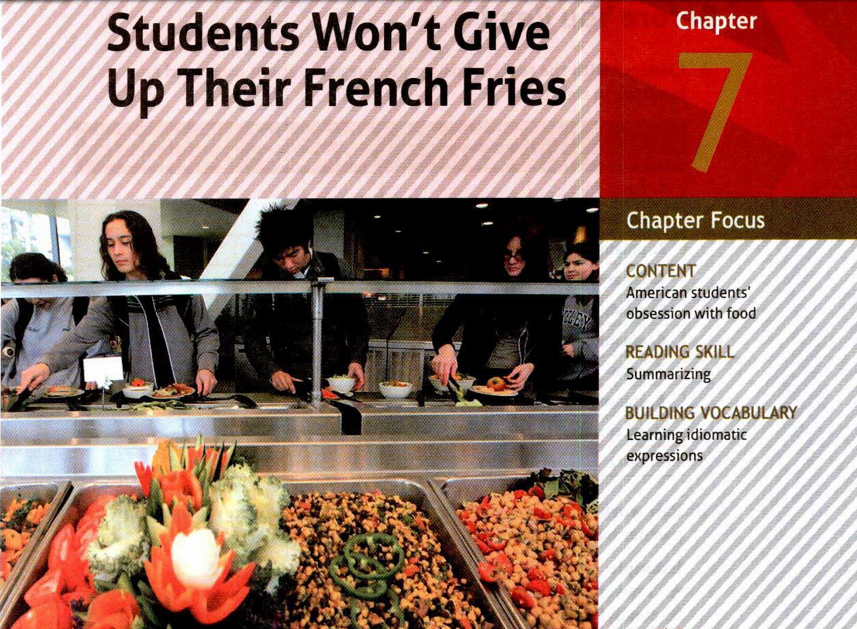
Students Won't Give Up Their French Fries
by Elizabeth F. Farrell from The Chronkle of Higher Education
دانش آموزان نمی خواهند سیب زمینی سرخ کرده خود را کنار بگذارند
توسط الیزابت اف. فارل از تاریخچه آموزش عالی
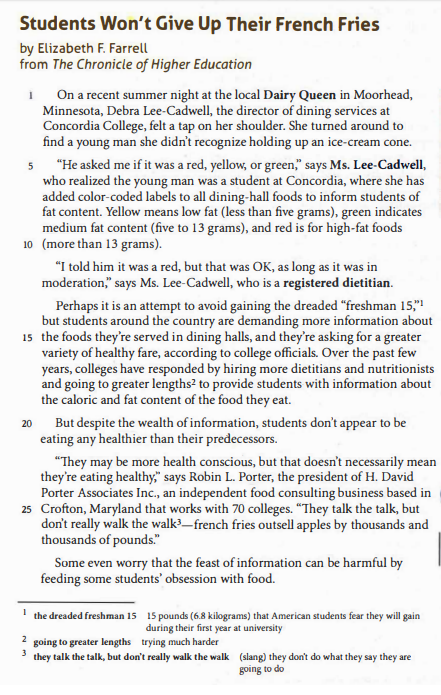
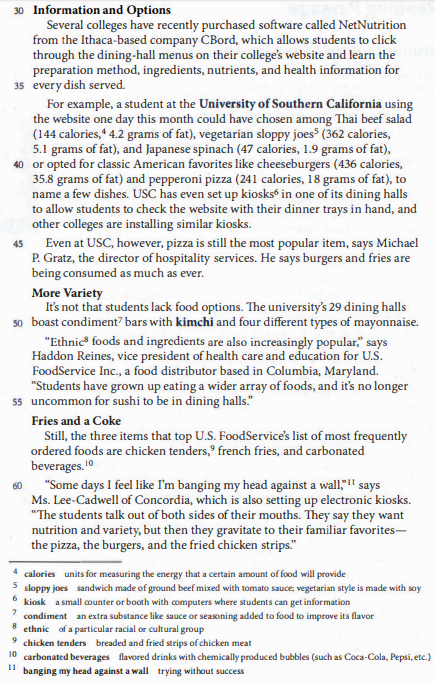
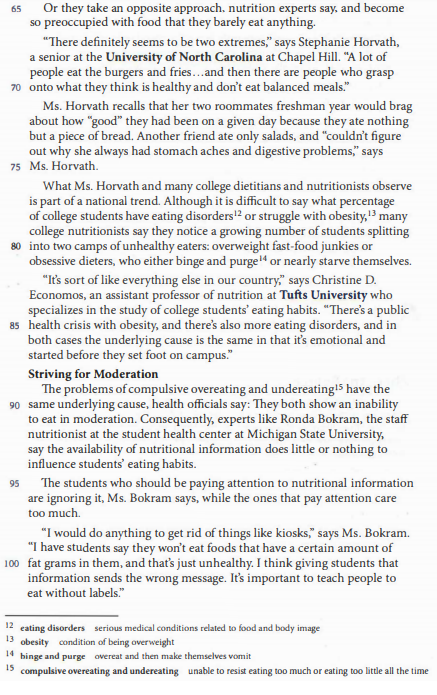
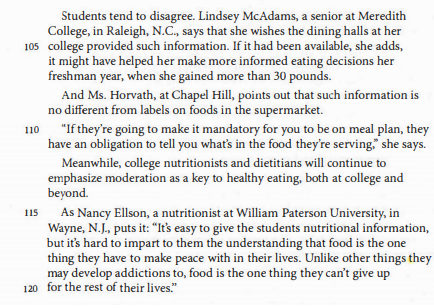
On a recent summer night at the local Dairy Queen in Moorhead, Minnesota, Debra Lee-Cadwell, the director of dining services at Concordia College, felt a tap on her shoulder. She turned around to find a young man she didn't recognize holding up an ice-cream cone.
اخیراً در یک شب تابستانی در کوئین دایری محلی در مورهد مینه سوتا، مدیر خدمات شام خوری در دانشکده کنکوردیا، خانم دبرا لی کادول ضربه ای را بر روی شانه خود احساس کرد. او برگشت و مرد جوانی را دید او متوجه بستنی قیفی دست او نشد.
"He asked me if it was a red, yellow, or green;' says Ms. Lee-Cadwell, who realized the young man was a student at Concordia, where she has added color-coded labels to all dining-hall foods to inform students of fat content. Yellow means low fat (less than five grams), green indicates medium fat content (five to ۱۳ grams), and red is for high-fat foods (more than ۱۳ grams).
خانم لی کادول می گوید، او از من پرسید این سبز، زرد یا سبز است. او متوجه شد که مرد جوان، دانشجوئی در کنکوردیا بود جائیکه او برچسب هایی با کدهای رنگی به همه غذاهای سالن غذاخوری اضافه کرده بود تا میزان چربی خوراکی ها را به دانشجویان اطلاع دهد. زرد به معنای کم چرب(کمتر از پنج گرم)، سبز نشان دهنده میزان چربی متوسط(پنج تا ۱۳ گرم) و قرمز برای غذاهای پرچرب است(بیش از ۱۳ گرم چربی).
"I told him it was a red, but that was OK, as long as it was in moderation;' says Ms. Lee-Cadwell, who is a registered dietitian
خانم لی کادول، که متخصص رژیم غذایی است می گوید؛ به او گفتم قرمز است اما تا وقتی که در حد اعتدال باشد مشکلی ندارد.
Perhaps it is an attempt to avoid gaining the dreaded "freshman but students around the country are demanding more information about the foods they're served in dining halls, and they're asking for a greater variety of healthy fare, according to college officials. Over the past few years, colleges have responded by hiring more dietitians and nutritionists and going to greater lengths۲ to provide students-with information about the caloric and fat content of the food they eat
شاید این تلاش برای جلوگیری از اضافه وزنی است که دانشجویان در سال اول دانشگاه به میزان ۶.۸ کیلوگرم پیدا می کنند اما دانشجویان سراسر کشور خواستار اطلاعات بیشتری در مورد غذاهایی هستند که در سالن های غذاخوری سرو می شود و بنا به گفته مسئولان دانشکده، آنها غذاهای متنوع تر و سالم تری را خواستارند. در طول سال های گذشته، دانشکده ها با استخدام متخصصین تغذیه و رژیم غذایی، تلاش بیشتری کرده اند تا اطلاعاتی در مورد کالری و مقدار چربی غذاهایی که دانشجویان می خورند، برای آنها فراهم کنند.
But despite the wealth of information, students don't appear to be eating any healthier than their predecessors.
اما با وجود این اطلاعات ارزشمند، به نظر نمی رسد که دانشجویان نسبت به دانشجویان قدیمی غذاهای سالم تری بخورند.
They may be more health conscious, but that doesn't necessarily mean they're eating healthy;' says Robin L. Porter, the president of H. David Porter Associates Inc., an independent food consulting business based in Crofton, Maryland that works with ۷۰ colleges. "They talk the talk, but don't really walk the walk۳-french fries outsell apples by thousands and thousands of pounds.
رابین ال پورتر رئیس هیئت مدیره اچ. دیوید پورتر و همکاران که کسب و کار مستقلی در زمینه مشاوره غذایی در کرفتون مریلند است و با ۷۰ دانشکده فعالیت می کند. می گوید؛ ممکن است آگاهی آنها در مورد سلامتی بیشتر باشد اما ضرورتاً به این معنا نیست که آنها سالم تر می خورند.
Some even worry that the feast of information can be harmful by feeding some students' obsession with food
برخی حتی نگرانند که چنین اطلاعات کامل و مفصلی می تواند برای تغذیه برخی دانشجویان که نسبت به غذا وسواس دارند، مضر باشد.
Information and Options
Several colleges have recently purchased software called NetNutrition from the Ithaca-based company CBord, which allows students to click through the dining-hall menus on their college's website and learn the preparation method, ingredients, nutrients, and health information for every dish served
اطلاعات و گزینه ها
اخیراً چندین دانشکده، نرم افزاری بنام نت نیوتریشن از ایتاکا شرکت مستقر در سی برد خریداری کرده اند که این امکان را به دانشجویان می دهد تا از طریق سایت دانشکده بر روی منوهای سالن غذاخوری کلیک کرده و در مورد روش تهیه، مواد تشکیل دهنده، مواد مغذی و اطلاعات بهداشتی هر غذایی که سرو می شود، اطلاع حاصل کنند.
For example, a student at the University of Southern California using the website one day this month could have chosen among Thai beef salad(۱۴۴ calories,۴ ۴.۲ grams of fat), vegetarian sloppy joes۵ (۳۶۲ calories, ۵.۱ grams of fat), and Japanese spinach (۴۷ calories, ۱.۹ grams of fat), or opted for classic American favorites like cheeseburgers ( ۴۳۶ calories, ۳۵.۸ grams of fat) and pepperoni pizza (۲۴۱ calories, ۱۸ grams of fat), to name a few dishes. USC has even set up kiosks in one of its dining halls to allow students to check the website with their dinner trays in hand, and other colleges are installing similar kiosks
به عنوان مثال یک دانشجو در دانشگاه کالیفرنیای جنوبی یک روز در این ماه توانست با استفاده از وب سایت از بین سالاد گوشت گاو تایلندی (۱۴۴ کالری، ۴.۲ گرم چربی)، ساندویچ گوشت و سویای گیاهخواری (۴۷ کالری، ۱.۹ گرم چربی)، یا غذاهای کلاسیک مورد علاقه آمریکائی ها همانند چیزبرگر(۴۳۶ کالری، ۳۵.۸ گرم چربی) و پیتزای پپرونی (۲۴۱ کالری، ۳۵.۸ گرم چربی) که چند نمونه غذا از میان هزاران نمونه است، انتخاب کند. یو اس سی حتی کیوسک هایی را در یکی از سالن های غذاخوری خود برپا کرده است تا دانشجویان با سینی های شام در دست، بتوانند وب سایت را بررسی کنند و سایر دانشکده ها هم کیوسک های مشابهی را نصب کرده اند.
Even at USC, however, pizza is still the most popular item, says Michael P. Gratz, the director of hospitality services. He says burgers and fries are being consumed as much as ever
مایکل پی گرتز، مدیر خدمات مهمان نوازی می گوید، در یو اس سی، پیتزا هنوز محبوب ترین مورد است. او می گوید همبرگر و سیب زمینی سرخ کرده به همان اندازه همیشه، مصرف می شود.
More Variety
It's not that students lack food options. The university's ۲۹ dining halls so boast condiment۷ bars with kimchi and four different types of mayonnaise. "Ethnic۸ foods and ingredients are also increasingly popular:' says Haddon Reines, vice president of health care and education for U.S. Foodservice Inc., a food distributor based in Columbia, Maryland. "Students have grown up eating a wider array of foods, and it's no longer uncommon for sushi to be in dining halls:
تنوع بیشتر
این طور نیست که دانشجویان گزینه های غذایی برای انتخاب نداشته باشند. سالن غذاخوری ۲۹ دانشگاه، ادعا می کند جایگاهای چاشنی دارد که کیمچی (کلم برگ ترشی انداخته و فلفل و سیر و غیره) و چهار نوع مختلف مایونز را ارائه می کنند. هادون راینز معاون بهداشتی و آموزش فود سرویس توزیع کننده مواد غذلیی در کلمبیا، مریلند می گوید مواد و غذاهای محلی نیز بسیار محبوب هستند. دانشجویان در حال خوردن طیف گسترده تری از غذاها هستند و دیگر غیرمعمول نیست که در سالن های غذاخوری سوشی باشد.
Fries and a Coke
Still, the three items that top U.S. FoodService's list of most frequently ordered foods are chicken tenders, french fries, and carbonated beverages.
سیب زمینی سرخ شده و کوکاکولا
سه موردی که هنوز در در بالای لیست سرویس غذایی ایالات متحده هستند و مکررا سفارش داده می شوند، چیکن تندر(برش های سرخ شده گوشت مرغ پوشیده شده با نان)، سیب زمینی سرخ شده و نوشیدنی های طعم دار و گازدار(پپسی، کوکاکولا) است.
Some days I feel like I'm banging my head against a wall;' says Ms. Lee-Cadwell of Concordia, which is also setting up electronic kiosks. The students talk out of both sides of their mouths. They say they want nutrition and variety, but then they gravitate to their familiar favorites-the pizza, the burgers, and the fried chicken strips
خانم لی کادول از کنکردیا که در حال راه اندازی کیوسک های الکترونیکی است می گوید؛ بعضی روزها شبیه این است که بیخودی خودم را به در دیوار میزنم و آب در هاون می کوبم. دانشجویان مبهم و دو پهلو صحبت می کنند. آنها می گویند غذاهای متنوع و مغذی می خواهند اما بعدش به سمت همان محبوب های آشنا - پیتزا، برگرها و تیکه های گوشت مرغ سرخ شده متمایل می شوند.
Or they take an opposite approach, nutrition experts say, and become so preoccupied with food that they barely eat anything. "There definitely seems to be two extremes:' says Stephanie Horvath, a senior at the University of North Carolina at Chapel Hill. "A lot of people eat the burgers and fries ... and then there are people who grasp onto what they think is healthy and don't eat balanced meals
کارشناسان تغذیه می گویند یا اینکه آنها رویکرد مخالفی را اتخاذ می کنند و آنقدر در مورد مواد غذایی وسواس به خرج می دهند، که به سختی چیزی می خورند. استفانی هوروات، از دانشجویان سال آخر دانشگاه کارولینای شمالی در چاپل هیل می گوید: به نظر می رسد که بطور قطعی دو افراط وجود دارد: تعداد زیادی از مردم برگرها و سیب زمینی ها و غیره را می خورند و از طرفی افرادی هستند که به آنچه فکر می کنند سالم است محکم چسبیده اند و غذاهای متعادل نمی خورند.
Ms. Horvath recalls that her two roommates freshman year would bragabout how "good" they had been on a given day because they ate nothing but a piece of bread. Another friend ate only salads, and "couldn't figure out why she always had stomach aches and digestive problems:· says Ms. Horvath
خانم هوروات به خاطر می آورد که دو هم اتاقی جدید الورودش با افتخار می گفتند که فلان روز چقدر خوب بوده اند که چیزی جزء یک تکه نان نخورده اند. دوست دیگری فقط سالاد می خورد و نمی توانست بفهمد چرا همیشه دل درد و مشکلات گوارشی دارد.
What Ms. Horvath and many college dietitians and nutritionists observe is part of a national trend. Although it is difficult to say what percentage of college students have eating disorders۱۲ or struggle with obesity, ۱۳ many college nutritionists say they notice a growing number of students splitting into two camps of unhealthy eaters: overweight fast-food junkies or obsessive dieters, who either binge and purge۱۴ or nearly starve themselves.
آنچه خانم هوروات و بسیاری از متخصصان تغذیه و رژیم غذایی دانشکده مشاهده می کنند، بخشی از یک گرایش ملی است. اگرچه دشوار است که بگوییم چند درصد از دانشجویان دانشکده دچار اختلالات خوردن هستند یا با چاقی در کشمکش هستد، خیلی از متخصصان تغذیه دانشکده می گویند که متوجه افزایش تعداد دانشجویانی که غذاهای ناسالم می خورند در دو گروه شده اند: چاق های معتاد به فست فود یا کسانی که با وسواس رژیم می گیرند؛ کسانیکه یا آنقدر می خورند که مجبور می شوند بالا بیاورند یا تقریباً دارند از گرسنگی خودشان را می کشند.
"It's sort of like everything else in our country;· says Christine D. Economos, an assistant professor of nutrition at Tufts University who specializes in the study of college students' eating habits. "There's a public health crisis with obesity, and there's also more eating disorders, and in both cases the underlying cause is the same in that it's emotional and started before they set foot on campus
کریستین دی اکونوس، استادیار تغذیه دانشگاه تافتز که متخصص مطالعه عادات غذایی دانشجویان دانشگاه است می گوید: این شبیه چیزهای دیگر کشور ماست. یک بحران سلامت عمومی با چاقی وجود دارد و همچنین اختلالات غذایی زیادی وجود دارد و در هر دو مورد دلیل اصلی این است که آن احساسی است و قبل از اینکه آنها پا به دانشگاه بگذارند شروع شده است.
Striving for Moderation
The problems of compulsive overeating and undereating have the same underlying cause, health officials say: They both show an inability to eat in moderation. Consequently, experts like Ronda Bokram, the staff nutritionist at the student health center at Michigan State University, say the availability of nutritional information does little or nothing to influence students' eating habits.
تلاش برای اعتدال
مسئولان بهداشتی می گویند: مشکلات پرخوری و کم خوری اجباری به دلایل زیر هستند. هر دوی آنها ناتوانی در خوردن در حد اعتدال را نشان می دهند. درنتیجه، کارشناسانی مانند روندا بوکرام، که متخصص تغذیه کارکنان در مرکز بهداشت دانشجویان در دانشگاه ایالتی میشیگان است می گوید، دسترسی به اطلاعات تغذیه ای فاقد تاثیر یا تاثیر کمی بر عادات غذایی دانشجویان دارد.
The students who should be paying attention to nutritional information are ignoring it, Ms. Bokram says, while the ones that pay attention care too much
خانم بوکرام می گوید، دانشجویانی که باید به اطلاعات تغذیه ای توجه کنند، آن را نادیده می گیرند درحالیکه کسانیکه توجه دارند، بیش از حد مراقبت می کنند.
"I would do anything to get rid of things like kiosks;' says Ms. Bokram. I have students say they won't eat foods that have a certain amount of fat grams in them, and that's just unhealthy. I think giving students that information sends the wrong message. It's important to teach people to eat without labels.
خانم بوکرام می گوید؛ من برای خلاص شدن از شر چیزهایی مانند کیوسک هر کاری می کنم. من دانشجویانی دارم که می گویند غذاهایی که مقدار چربی معینی داشته باشند را نمی خورند که این خود ناسالم است. من فکر می کنم دادن این اطلاعات به دانشجویان، پیغام اشتباهی را ارسال می کند. مهم این است که به اشخاص آموزش داده شود که بدون برچسب ها غذا بخورند.
Students tend to disagree. Lindsey McAdams, a senior at Meredith College, in Raleigh, N.C., says that she wishes the dining halls at her college provided such information. If it had been available, she adds, it might have helped her make more informed eating decisions her freshman year, when she gained more than ۳۰ pounds
دانشجویان تمایل به مخالفت دارند. لیندسی مک آدام یکی از دانشجویان سال آخر در دانشکده مردیت در رالیگ می گوید، که آرزو دارد سالن های غذاخوری در دانشکده او چنین اطلاعاتی را ارائه می دادند. او افزود، وقتی او سال اولی بود و بیش از ۳۰ پوند اضافه وزن پیدا کرد، اگر این اطلاعات در دسترس بود؛ ممکن بود، به او کمک می کرد تصمیمات آگاهانه بیشتری بگیرد.
And Ms. Horvath, at Chapel Hill, points out that such information is no different from labels on foods in the supermarket.
و خانم هوروات، در چاپل هیل، خاطرنشان می کند که چنین اطلاعاتی هیچ تفاوتی با برچسب های غذاها در سوپر مارکت ندارد.
"If they're going to make it mandatory for you to be on meal plan, they have an obligation to tell you what's in the food they're serving;' she says. Meanwhile, college nutritionists and dietitians will continue to emphasize moderation as a key to healthy eating, both at college and beyond
او می گوید؛ اگر آنها می خواهند برنامه غذایی را برای شما اجباری کنند، وظیفه دارند به شما بگویند که چه چیز در غذایی که سرو می کنند، وجود دارد. در همین حال، متخصصان تغذیه و رژیم غذایی دانشکده، همچنان بر اعتدال به عنوان کلید تغذیه سالم در دانشکده و فراسوی آن تاکید می کنند.
As Nancy Ellson, a nutritionist at William Paterson University, in Wayne, N.J., puts it: "It's easy to give the students nutritional information, but it's hard to impart to them the understanding that food is the one thing they have to make peace with in their lives. Unlike other things they may develop addictions to, food is the one thing they can't give up for the rest of their lives
همانطور که نانسی ایلسون، متخصص تغذیه در دانشگاه ویلیام پاترسون در وین نیوجرسی اظهار داشت: دادن اطلاعات تغذیه ای به دانشجویان آسان است اما فهماندن اینکه غذا چیزی است که آنها باید در زندگی خود، آن را بپذیرند و با آن آشتی کنند، سخت است. برخلاف چیزهای دیگر که ممکن است به آنها اعتیاد پیدا کنند، غذا چیزی است که نمی توانند برای مابقی عمرشان از آن دست بردارند.

